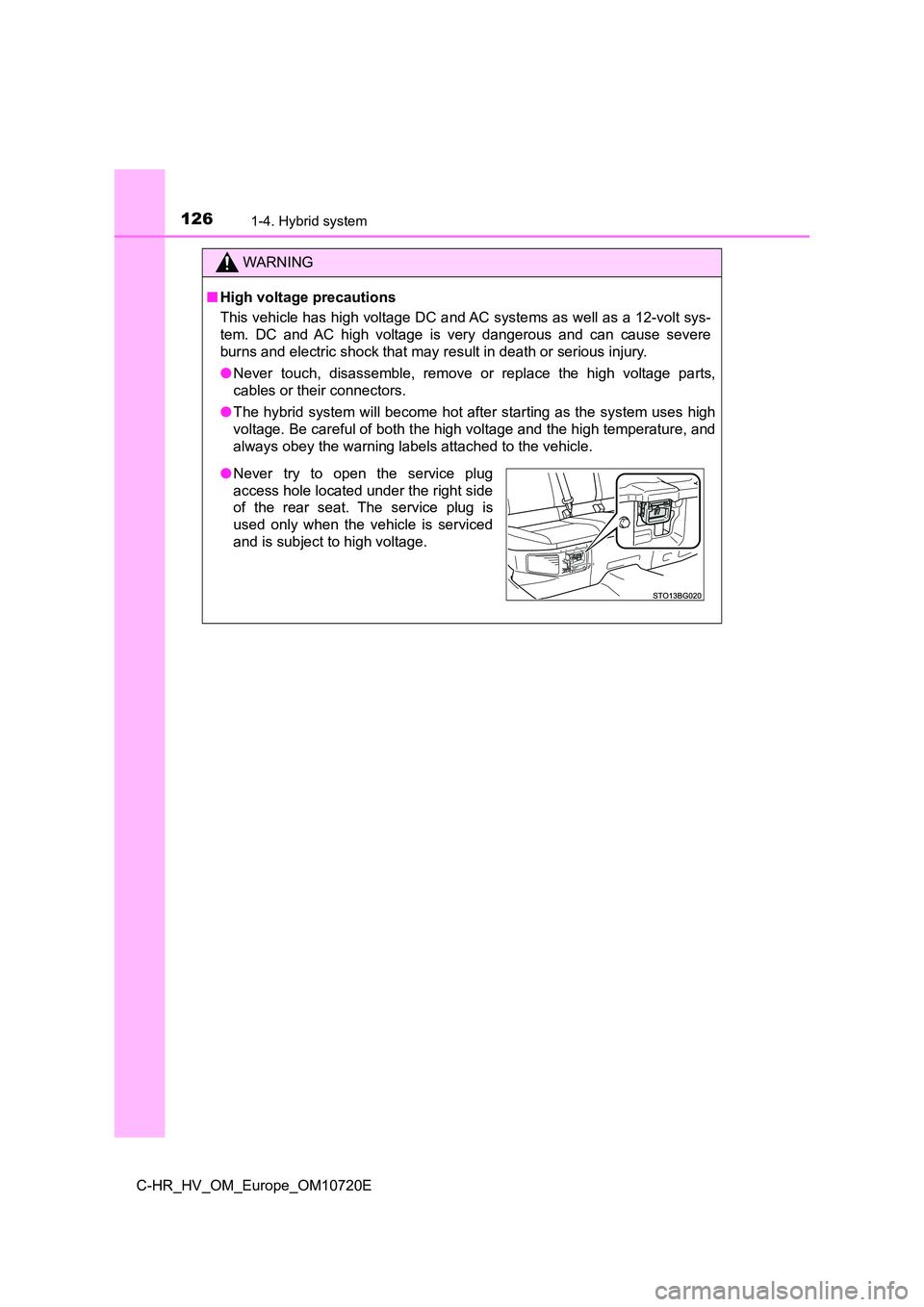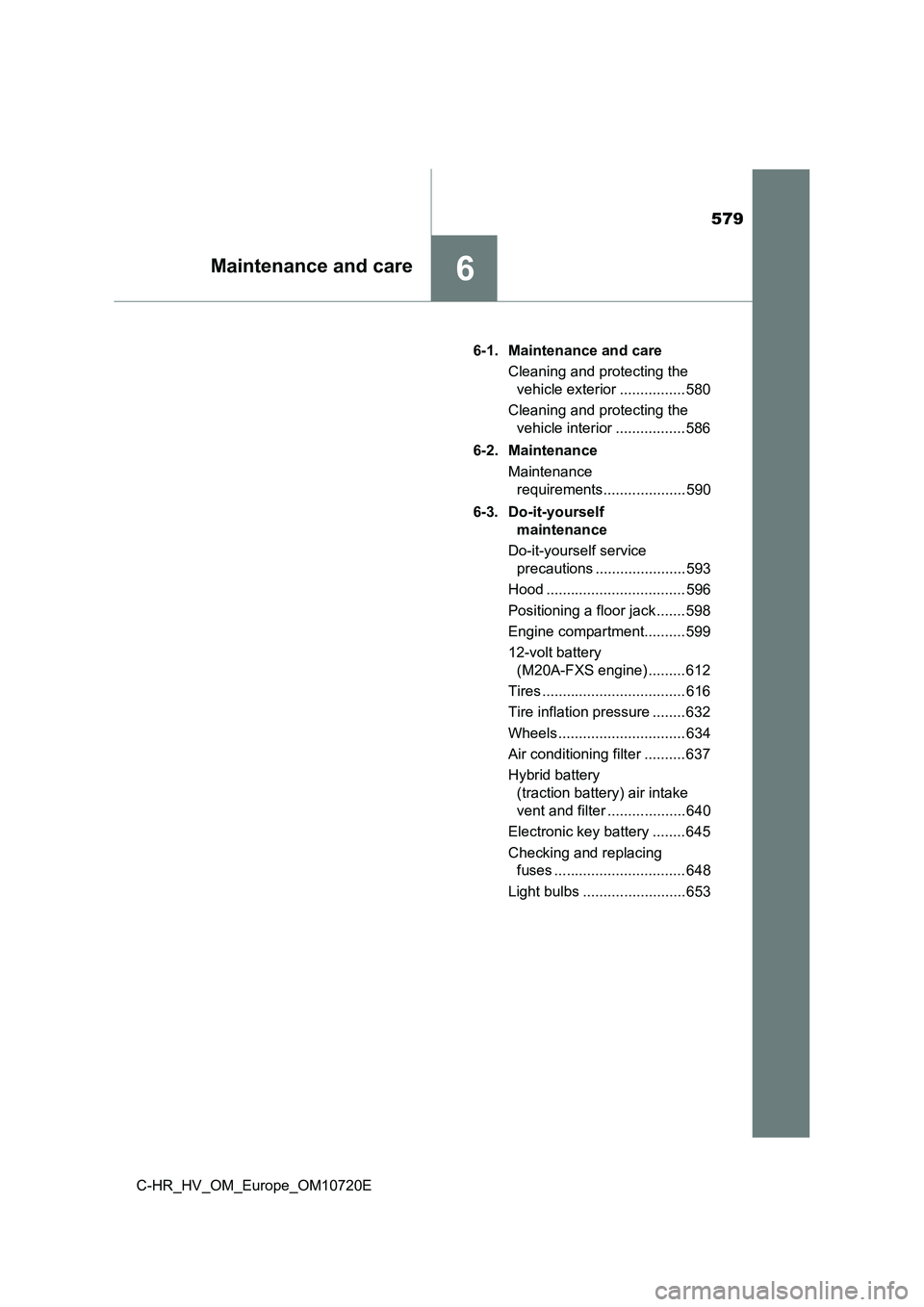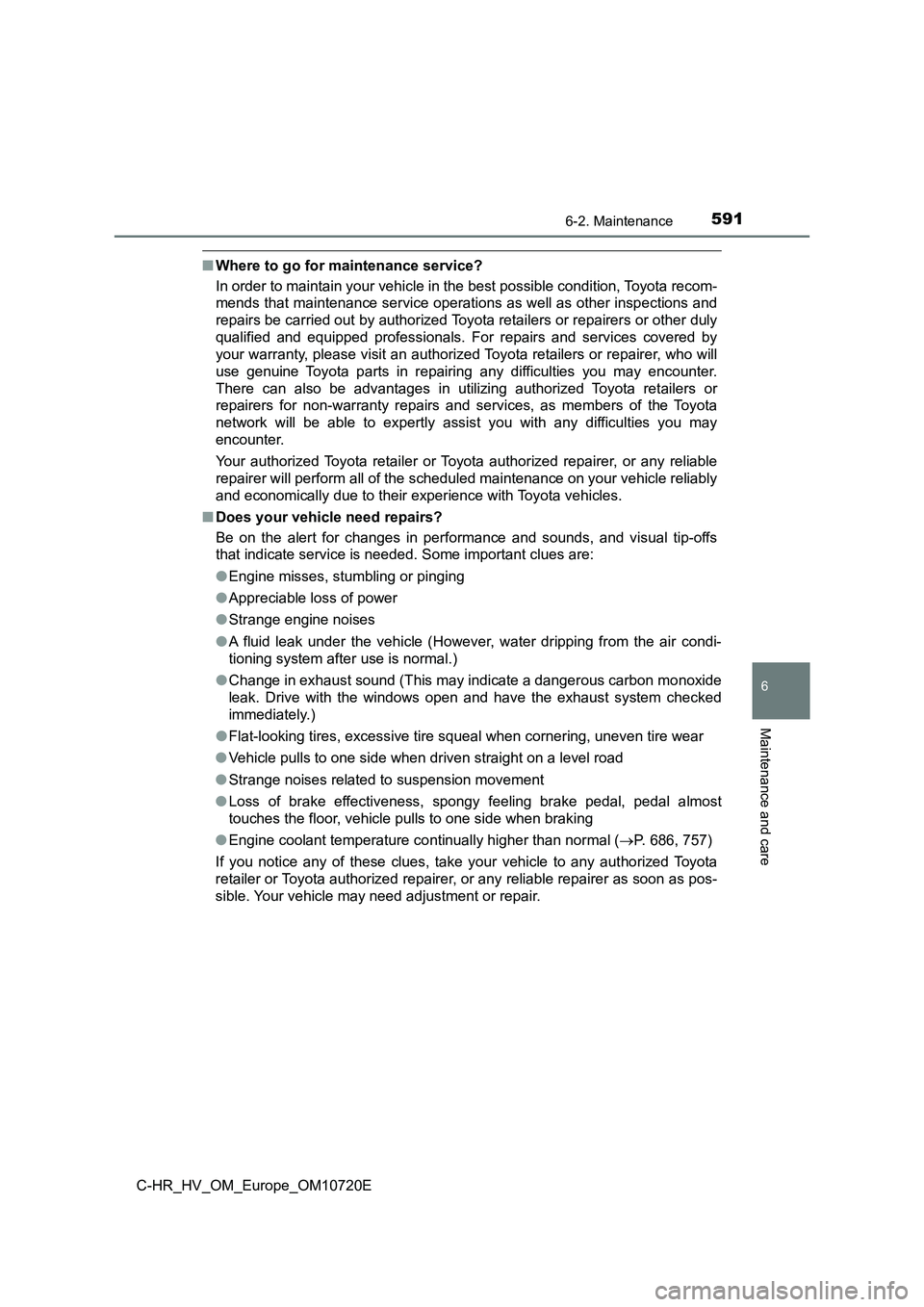service TOYOTA C-HR 2022 User Guide
[x] Cancel search | Manufacturer: TOYOTA, Model Year: 2022, Model line: C-HR, Model: TOYOTA C-HR 2022Pages: 818, PDF Size: 113.75 MB
Page 125 of 818

123
1
1-4. Hybrid system
For safety and security
C-HR_HV_OM_Europe_OM10720E
Hybrid system precautions
The illustration is an example for explanation and may differ from the
actual item.
Take care when handling the hybrid system, as it is a high volt -
age system (about 600 V*1 or 650 V*2 at maximum) as well as
contains parts that become extremely hot when the hybrid sys-
tem is operating. Obey the warning labels attached to the vehi-
cle.
*1: 2ZR-FXE engine
*2: M20A-FXS engine
Warning label
Service plug
Hybrid battery (traction battery)
High voltage cables (orange)
Electric motor (traction motor)
Power control unit
Air conditioning compressor
Page 127 of 818

1251-4. Hybrid system
1
For safety and security
C-HR_HV_OM_Europe_OM10720E
■If a warning light comes on, a warning message is displayed, or the
12-volt battery is disconnected
The hybrid system may not start. In this case, try to start the system again. If
the “READY” indicator does not come on, contact any authorized To y o t a
retailer or Toyota authorized repairer, or any reliable repaire r.
■ Running out of fuel
When the vehicle has run out of fuel and the hybrid system cann ot be started,
refuel the vehicle with at leas t enough gasoline to make the low fuel level
warning light ( P. 685) go off. If there is only a small amount of fuel, the
hybrid system may not be able to start. (The standard amount of fuel is about
7.5 L [2.0 gal., 1.7 Imp.gal.], when the vehicle is on a level surface. This value
may vary when the vehicle is on a slope. Add extra fuel when th e vehicle is
inclined.)
■ Electromagnetic waves
● High voltage parts and cables on Hybrid Electric Vehicles incorporate elec-
tromagnetic shielding, and therefore emit approximately the sam e amount
of electromagnetic waves as conventional gasoline powered vehic les or
home electronic appliances.
● Your vehicle may cause sound interference in some third party-produced
radio parts.
■ Hybrid battery (traction battery)
The hybrid battery (traction battery) has a limited service lif e. The lifespan of
the hybrid battery (traction battery) can change in accordance with driving
style and driving conditions.
■ Declaration of conformity
This model conforms to hydrogen emissions according to regulati on ECE100
(Battery electric vehicle safety).
Page 128 of 818

1261-4. Hybrid system
C-HR_HV_OM_Europe_OM10720E
WARNING
■High voltage precautions
This vehicle has high voltage DC and AC systems as well as a 12 -volt sys-
tem. DC and AC high voltage is very dangerous and can cause sev ere
burns and electric shock that may result in death or serious in jury.
● Never touch, disassemble, remove or replace the high voltage parts,
cables or their connectors.
● The hybrid system will become hot after starting as the system uses high
voltage. Be careful of both the high voltage and the high tempe rature, and
always obey the warning labels attached to the vehicle.
● Never try to open the service plug
access hole located under the right side
of the rear seat. The service plug is
used only when the vehicle is serviced
and is subject to high voltage.
Page 130 of 818

1281-4. Hybrid system
C-HR_HV_OM_Europe_OM10720E
WARNING
■Hybrid battery (traction battery)
● 2ZR-FXE engine (except for Guadelope, Martinique, F. Guiana and
Greenland): Your vehicle contains a sealed lithium-ion battery.
● Never resell, hand over or modify the hybrid battery. To prevent accidents,
hybrid batteries that have been removed from a disposed vehicle are col-
lected through any authorized Toyota retailer or Toyota authori zed repairer,
or any reliable repairer. Do not dispose of the battery yoursel f.
Unless the battery is properly collected, the following may occ ur, resulting
in death or serious injury:
• The hybrid battery may be illegally disposed of or dumped, and it is haz-
ardous to the environment or someone may touch a high voltage p art,
resulting in an electric shock.
• The hybrid battery is intended to be used exclusively with you r Hybrid
Electric Vehicle. If the hybrid battery is used outside of your vehicle or
modified in any way, accidents such as electric shock, heat gen eration,
smoke generation, an explosion and electrolyte leakage may occur.
When reselling or handing over your vehicle, the possibility of an accident
is extremely high because the person receiving the vehicle may not be
aware of these dangers.
● If your vehicle is disposed of without the hybrid battery having been
removed, there is a danger of serious electric shock if high vo ltage parts,
cables and their connectors are touched. In the event that your vehicle
must be disposed of, the hybrid battery must be disposed of by any autho-
rized Toyota retailer or Toyota authorized repairer, or any rel iable repairer
or a qualified service shop. If the hybrid battery is not dispo sed of properly,
it may cause electric shock that can result in death or serious injury.
Page 545 of 818

543
4
4-6. Driving tips
Driving
C-HR_HV_OM_Europe_OM10720E
Winter driving tips
●Use fluids that are appropriate to the prevailing outside tempera-
tures.
• Engine oil
• Engine/power control unit coolant
• Washer fluid
● Have a service technician inspect the condition of the 12-volt bat-
tery.
● Have the vehicle fitted with four snow tires or purchase a set of tire
chains for the front tires*.
Ensure that all tires are the same size and brand, and that cha ins match
the size of the tires.
*: Tire chains cannot be mounted on 18-inch tires or 19-inch tir es.
Perform the following according to the driving conditions:
● Do not try to forcibly open a window or move a wiper that is frozen.
Pour warm water over the frozen area to melt the ice. Wipe away
the water immediately to prevent it from freezing.
● To ensure proper operation of the climate control system fan,
remove any snow that has accumulated on the air inlet vents in
front of the windshield.
● Check for and remove any excess ice or snow that may have accu-
mulated on the exterior lights, vehicle’s roof, chassis, around the
tires or on the brakes.
● Remove any snow or mud from the bottom of your shoes before
getting in the vehicle.
Carry out the necessary preparations and inspections before
driving the vehicle in winter. Always drive the vehicle in a ma n-
ner appropriate to the prevailing weather conditions.
Preparation for winter
Before driving the vehicle
Page 581 of 818

579
6Maintenance and care
C-HR_HV_OM_Europe_OM10720E
6-1. Maintenance and care
Cleaning and protecting the
vehicle exterior ................ 580
Cleaning and protecting the
vehicle interior ................. 586
6-2. Maintenance
Maintenance
requirements.................... 590
6-3. Do-it-yourself
maintenance
Do-it-yourself service
precautions ...................... 593
Hood .................................. 596
Positioning a floor jack ....... 598
Engine compartment.......... 599
12-volt battery
(M20A-FXS engine) ......... 612
Tires ................................... 616
Tire inflation pressure ........ 632
Wheels ............................... 634
Air conditioning filter .......... 637
Hybrid battery
(traction battery) air intake
vent and filter ................... 640
Electronic key battery ........ 645
Checking and replacing
fuses ................................ 648
Light bulbs ......................... 653
Page 592 of 818

5906-2. Maintenance
C-HR_HV_OM_Europe_OM10720E
Maintenance requirements
Scheduled maintenance should be performed at specified intervals
according to the maintenance schedule.
For full details of your maintenance schedule, refer to the “To yota Service
Booklet” or “Toyota Warranty Booklet”.
What about do-it-yourself maintenance?
Many maintenance items are easy to do yourself if you have a li ttle
mechanical ability and a few basic automotive tools.
Note, however, that some maintenance tasks require special tool s and
skills. These are best performed by qualified technicians. Even if you’re an
experienced do-it-yourself mechanic, we recommend that repairs and
maintenance be conducted by any authorized Toyota retailer or T oyota
authorized repairer, or any reliable repairer. Any authorized T oyota retailers
or repairer will keep a record of maintenance, which could be u seful should
you ever require Warranty Service. Should you choose to select a qualified
and equipped professional other than an authorized Toyota repai rer to ser-
vice or maintain your vehicle, we recommend that you request th at a
record of maintenance be kept.
To ensure safe and economical driving, day-to-day care and reg-
ular maintenance are essential. Toyota recommends the follow-
ing maintenance:
Scheduled maintenance
Do-it-yourself maintenance
Page 593 of 818

5916-2. Maintenance
C-HR_HV_OM_Europe_OM10720E
6
Maintenance and care
■Where to go for maintenance service?
In order to maintain your vehicle in the best possible conditio n, Toyota recom-
mends that maintenance service operations as well as other insp ections and
repairs be carried out by authorized Toyota retailers or repair ers or other duly
qualified and equipped professionals. For repairs and services covered by
your warranty, please visit an authorized Toyota retailers or r epairer, who will
use genuine Toyota parts in repairing any difficulties you may encounter.
There can also be advantages in utilizing authorized Toyota ret ailers or
repairers for non-warranty repairs and services, as members of the Toyota
network will be able to expertly assist you with any difficulti es you may
encounter.
Your authorized Toyota retailer or Toyota authorized repairer, or any reliable
repairer will perform all of the scheduled maintenance on your vehicle reliably
and economically due to their experience with Toyota vehicles.
■ Does your vehicle need repairs?
Be on the alert for changes in performance and sounds, and visu al tip-offs
that indicate service is needed. Some important clues are:
● Engine misses, stumbling or pinging
● Appreciable loss of power
● Strange engine noises
● A fluid leak under the vehicle (However, water dripping from the air condi-
tioning system after use is normal.)
● Change in exhaust sound (This may indicate a dangerous carbon monoxide
leak. Drive with the windows open and have the exhaust system c hecked
immediately.)
● Flat-looking tires, excessive tire squeal when cornering, uneven tire wear
● Vehicle pulls to one side when driven straight on a level road
● Strange noises related to suspension movement
● Loss of brake effectiveness, spongy feeling brake pedal, pedal almost
touches the floor, vehicle pulls to one side when braking
● Engine coolant temperature continually higher than normal (P. 686, 757)
If you notice any of these clues, take your vehicle to any auth orized Toyota
retailer or Toyota authorized repairer, or any reliable repaire r as soon as pos-
sible. Your vehicle may need adjustment or repair.
Page 605 of 818

6036-3. Do-it-yourself maintenance
C-HR_HV_OM_Europe_OM10720E
6
Maintenance and care
WARNING
■Used engine oil
● Used engine oil contains potentially harmful contaminants which may
cause skin disorders such as inflammation and skin cancer, so c are
should be taken to avoid prolonged and repeated contact. To rem ove used
engine oil from your skin, wash thoroughly with soap and water.
● Dispose of used oil and filters only in a safe and acceptable manner. Do
not dispose of used oil and filters in household trash, in sewe rs or onto the
ground. Call any authorized Toyota retailer or Toyota authorize d repairer,
or any reliable repairer service station or auto parts store fo r information
concerning recycling or disposal.
● Do not leave used engine oil within the reach of children.
NOTICE
■To prevent serious engine damage
Check the oil level on a regular basis.
■ When replacing the engine oil
● Be careful not to spill engine oil on the vehicle components.
● Avoid overfilling, or the engine could be damaged.
● Check the oil level on the dipstick every time you refill the vehicle.
● Be sure the engine oil filler cap is properly tightened.
Page 633 of 818

6316-3. Do-it-yourself maintenance
C-HR_HV_OM_Europe_OM10720E
6
Maintenance and care
NOTICE
■Repairing or replacing tires, wheels, tire pressure warning valves,
transmitters and tire valve caps
● When removing or fitting the wheels, tires or the tire pressure warning
valves and transmitters, contact any authorized Toyota retailer or Toyota
authorized repairer, or any reliable repairer as the tire press ure warning
valves and transmitters may be damaged if not handled correctly .
● Make sure to install the tire valve caps. If the tire valve caps are not
installed, water could enter the tire pressure warning valves a nd the tire
pressure warning valves could be bound.
● When replacing tire valve caps, do not use tire valve caps other than those
specified.
The cap may become stuck.
■ Driving on rough roads
Take particular care when driving on roads with loose surfaces or potholes.
These conditions may cause losses in tire inflation pressure, r educing the
cushioning ability of the tires. In addition, driving on rough roads may cause
damage to the tires themselves, as well as the vehicle’s wheels and body.
■ To avoid damage to the tire pressure warning valves and transmitters
When a tire is repaired with liquid sealants, the tire pressure warning valve
and transmitter may not operate properly. If a liquid sealant i s used, contact
any authorized Toyota retailer or Toyota authorized repairer, o r any reliable
repairer or other qualified service shop as soon as possible. A fter use of liq-
uid sealant, make sure to replace the tire pressure warning val ve and trans-
mitter when repairing or replacing the tire. ( P. 618)
■ If tire inflation pressure of each tire becomes low while driving
Do not continue driving, or your tires and/or wheels may be rui ned.